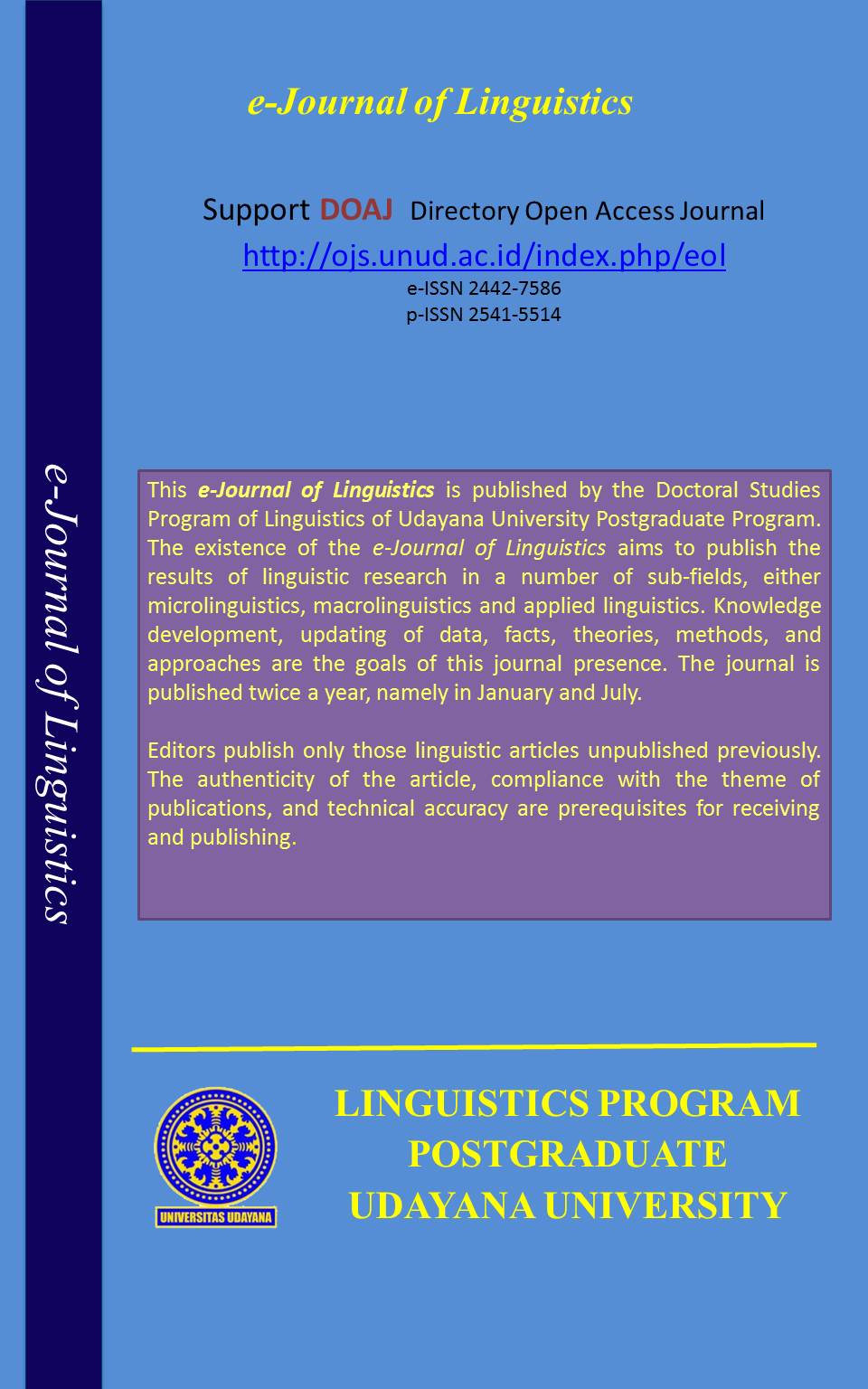10.24843 The Variation of Sentence Structure in the Dyslexic Children’s Speech
Abstract
This study aims to describe the variation of sentence structure generated in the speech of dyslexic children. The design of this research is descriptive-qualitative with pospositivisme approach of interpretive phenomenology of naturalistic model. The research subjects were nine dyslexic children who used Indonesian as the first language and aged 8 to 10 years. The method used is listening and speaking method. In practice, the distributional method used by researcher are the IC technique. As an aid, the IC technique is supported by special techniques as an advanced techniques: Deletion, Substitution, Paraphrase, Perversion, and Expansion. From the research, it concluded that the Indonesian sentences produced by dyslexic children are dominated by incomplete sentences (59.61%), while complete sentences (40.39%) are the rest. Most complete sentences are basic sentences, while some are derivative sentences. From the basic sentence that appears, 38.66% basic sentence predicated verbs with the pattern of NP + VP, predicated noun patterned NP1 + NP2 with percentage 26.66%, predicated adjective with NP + AP pattern of 23.55%, predicate the preposition patterned NP + PP of 5.78%, and the last predicate numeral with NP + NumP pattern of 4.88%. The derivation sentence is dominated by single sentence with percentage value 97,62%, compound sentence equal to 0,44%, and multi-story sentence equal to 1,94%. The incomplete sentences conveyed by DC consist of the SUBJ only structure pattern, PRED only, OBJ only, ADJ only, or combined functions of SUBJ-OBJ, SUBJ-ADJ, PRED-OBJ, PRED-ADJ, and PRED-OBJ-ADJ.
Downloads
References
Arka, I Wayan. 1998. “From Morphosyntax to Pragmatics in Baliness: A Lexical-Functional Approach”. (dissertation). Sydney, Australia: University of Sydney.
Artawa, Ketut. 1996. Keergatifan Sintaksis di dalam Bahasa: Bahasa Bali, Sasak, dan Indonesia. Dalam PELBA 10. Jakarta: Lembaga Bahasa Universitas Katolik Atmajaya.
Brown, Roger. 1973. A First Language. Middlesex: Pinguin Bos Ltd.
Byrne, B. 1981. Deficient syntactic control in poor readers: Is aweak phoneticmemory code responsible? Applied Psycholinguistics 2 (20). hlm. 201–212.
Chomsky, Noam. 1965. Aspects of the Theory of Syntax. Cambridge: MIT Press.
Dardjowidjojo, Sunjono. 2000. Echa: Kisah Pemerolehan Bahasa Anak. Jakarta: Grasindo.
Fisher, S. and DeFries, J. 2002. “Developmental Dyslexia: Genetic Dissection of a Complex Cognitive Trait”, Nature Reviews 3, hlm. 767–7781.
Givon, Talmy. 1984. Syntax : A Functional Typological Introduction. Vol I.
Amsterdam : John Benjamins
Kirk, Samuel A. dan James J., Gallagher. 1989. Educating Exceptional Children. EdisiVI. Boston: Houghton Mifflin Company.
Mercer-Cecil, D. and Mercer-Ann, R. 1989. Teaching Students with Learning Problems (third ed.). Ohio USA: Merril Publishing Company A Bell & Howell Company.
Moleong, Lexy. 2008. Metode Penelitian Kualitatif. Edisi Kedua. Bandung: Rosdakarya.
Morkena, Frøydis, dkk. 2017. Reading in dyslexia across literacy development: A longitudinal study ofeffective connectivity. NeuroImage 144 (2017) 92–100 [Online]. Tersedia:http://dx.doi.org/10.1016/j.neuroimage.2016.09.060[diunduh pada 26 Mei 2017].
Morris, R.; Shaywitz, S. & Shaywitz, B. (2008), The Education of Dyslexic Children from Childhood to Young Adulthood. Annu. Rev. Psychol.2008.59:451-475. Tersedia: http://www.decodingdyslexiaor.org/wp-content/uploads/2015/01/ Shaywitz-dyslexia-Review-2008-Ann-Rev-Psychol.pdf
Purwandari, (2001). Kebutuhan SosioPsikologis Anak Berkesulitan Belajar (Buku Pegangan Kuliah).Yogyakarta: FIP UNY
Reggiani, Danilo. 2012. “Dyslexia and the Acquisition of Syntax Passive and Control”. (disertasi). Verona: Universita Degli.Shaywitz, S.E. 1998. Dyslexia. N Engl J Medic, 338:307—31
Snowling, M.J., Hulme, C., 2012. Annual research review: the nature and classification ofreading disorders – a commentary on proposals for DSM-5. J. Child Psychol. Psychiatry 53, 593–607. http://dx.doi.org/10.1111/j.1469-7610.2011.02495.x.
Verhaar, John.W.M. 1996. Asas-Asas Linguistik Umum. Yogyakarta: Gadjah Mada University Press.

This work is licensed under a Creative Commons Attribution 4.0 International License











